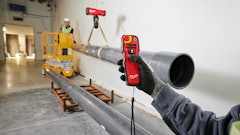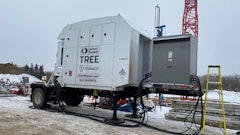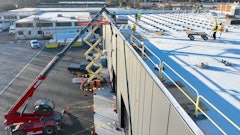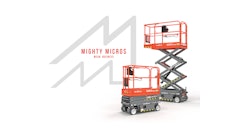
Electric scissor lifts can be very useful tools on many jobsites, and fortunately, manufacturers have worked hard to produce machines that are highly productive with low maintenance requirements. Still, to get the most life out of your fleet, you need to be diligent about inspecting your machines when they return from a rental.
At first glance
The first step to any inspection should be an evaluation of the general integrity and safety of the machine. This begins with a visual check for any obvious damage such as bent rails, broken handles, missing guardrail pins, loose wheel lug nuts and any leaks. In addition to glancing at the overall machine, closely examine the deck and deploy the extension to see if all is working properly.
The next part of the inspection focuses on the scissor stack. This is the most important part of the machine when it comes to safety and longevity, but it's the hardest part to inspect. To get a good look at the machine, make sure everything is at eye level so it's easier to see problem areas.
While the machine is in the lowered position, look for cracks or rusted areas around the pins and bushings, as well as near the welds where the pins and bushings are mounted. Look for signs of unusual wear, including metal shavings and elongated pins or bushings. Tolerances must be tight and there shouldn't be any unusual gaps.
Many manufacturers are responding to the requests of rental businesses by eliminating excessive greasing on their scissor lift models. As a result, many electric scissor lifts have no grease zerks, but use "dry" bushings instead.
While greasing is largely eliminated, the slide blocks, which attach the base of the scissor lift to its scissor stack, do require regular lubrication.
Following the stack inspection, check for tire integrity. It's important to look for bad gashes or peels since it's not uncommon for tires to become badly damaged during loading and unloading from trailer ramps.
Close to the tires is the pothole protection system. Check to be sure the plates are properly pinned to the chassis and can move freely. Always check the pothole protection system from the ground. Raise and lower the machine with the system deployed to ensure proper operation. Sometimes, if the pothole protection system is actually deployed on a jobsite, the plate can become damaged and will need to be replaced or repaired.
Be sure to check the safety prop or scissor stack locking device. This brace should be used during maintenance to ensure the machine doesn't drop shut during service procedures. Check to be sure the prop is in place and intact before performing any maintenance on the machine.
Now remove the prop and locate the emergency lowering device. Confirm it works by lowering the scissor lift.
The inner workings
When inspecting the working parts of an electric scissor lift, start by checking the hydraulic manifold compartment and look at the hoses and fittings for wear or leaks. Inspect the drive motor cables for frays, cuts and any other obvious damage. Check for leaks in the steering cylinder by looking on the floor of your shop. Leaks will be highly evident on concrete surfaces, but not so easily detectable on asphalt, so be sure to give the area a keen visual inspection.
Also look at the lower control box assembly, paying close attention to the ignition switch. Then check to ensure that the emergency stop switch is operable.
At this point, check the battery compartment and look for any loose connections, low water levels and cracked cases or missing caps.
Don't forget to look at the static strip, the rubber strap that drags along the ground during operation. On models with pale tires, this strap collects static electricity, preventing shocks. This feature is not necessary on models with black tires, as the dye in the rubber kills any static electricity that could otherwise build up when traveling over carpets or other electrically conductive surfaces.
Optimal operation
Now that the general inspection is complete, it's time to check the machine's operation. Start at ground level and work your way up. First, check the manual descent cable that allows a person on the ground to lower the machine.
Next, visually inspect the OSHA-required safety chain and check to see if all required decals are legible and in place. If not, replace them as needed.
Next, mount the lift and check for all functions from the upper control box. Many machines today are equipped with a removable control box to deter theft. Check the connecting cable and the general condition of the box.
Ensure steering works properly by moving the machine to the left, right and back to center. On a level surface, listen for any groaning or whining of the hydraulics. Now drive the machine forward and backward.
The machine should cutout from high drive to low speed (in the drive mode) after raising the platform a few feet. When descending, be sure there is no binding or creaking from the scissor stack.
Check the integrity of the machine's tie points and take a look in the manual compartment to be sure the model-specific owner's manual is there, along with the manufacturer-supplied "green safety manual" and any OSHA or ANSI spec sheets.
During operation, the machine should feel balanced and steady. There should be no vibration felt during ascent or descent. Wheels should turn properly and drive speeds, as well as speeds for ascent and descent, should be constant and appropriate.
On the surface
The last thing to consider is the cosmetic appearance of the machine. Always pressure wash the scissor lift when it comes back in from a rental. This will make problem areas easier to spot and fix. Touch up paint where possible on newer pieces. On older, faded pieces, you might want to repaint the entire part or simply leave it alone. Touching up the paint in those cases might just draw attention to the problem. On vital, discontinued models that you want to get maximum life out of, repainting the entire unit might be a sound decision.
Often, electric scissor lifts are rented to painting contractors and brought back badly discolored. In cases like that, it's fair to charge the customer for the damage. If you're a rental house with a sizable stable of lift equipment, you can prevent such situations by designating one lift to be used by painting contractors exclusively.
When done with the inspection, connect the charger to an electrical outlet so the battery recharges. Most new model battery chargers make this simple, as a light will come on to let you know the machine is charging correctly.
The last thing to do after a full inspection is to tag the machine indicating it's 100 percent ready for rental.
If inspected and maintained diligently, an electric scissor lift can serve your rental inventory for a decade or more. And with all the uses these machines are good for, that decade could translate into a significant boon to your bottom line.
Information provided by EquipWholesale.com, Genie Industries, Illini Hi-Reach Inc. and JLG Industries.



























